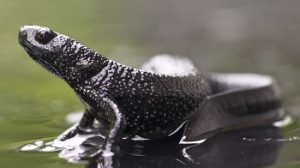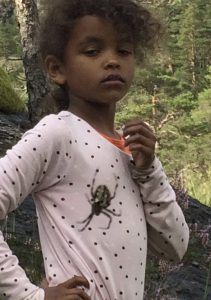 Storsalamander (Triturus cristatus)
Storsalamander (Triturus cristatus)
Salamander Hunt
Salamanderen (the newt), with its strong mating colors, has always given a strong magical appeal, near the line concerning the shapeshifting fairy musician “Nykkjen”. In work involving alchemy the newt represent, together with other gargoyles, the elementary spirits:
Fire: …………………………….the newt
Water: …………………………undines
Air: ……………………………..sylfides
Earth: ………………………….gnomes and dwarves
Ether (the fifth element): the Sfinx and the Unicorn
Hatlestrand has got Northern Europe’s largest deposit of the rare and protected “storsalamander”.
Locally, they always been named as lizards (oegler). Formally, today they are reckorded as amphibians.
In the long term we calculate that the salamander will establish itself in Lundarhegni Nature Park. Today it is easyest to find in Geitaknottane Nature Reserve, a pretty remote place. If you want to avoid a wasted journey, we advise to use a guide.
Deer Safari
Hatlestrand and Oelve is important areas for wild deers. Lundarhegni do not convey hunting with guns. Such hunting are neither allowed inside the park. But since the deer feels relatively safe there, and since they migrate through, camera hunting perform well.
Leit summer and autumn is best time for deer safari. Guided tour can be recommended.
Eikelandselvi
We follow the river of Eikeland, from it’s mouth in Hjortaasvaagen to it’s birth place in Trodladalen (the valley of trolls).
Quarries
Are the old pyrite slate quarries of Hatlestrand and Oelve hiding remains of one of the first industrial activities in Norway?
Baking plates, grinding stone from Gotland and rock of glas *
Mining (iron, pyrite and gold)
Jabergsmoget, Dyråsen and Attramadal
ChristianGavesVerk *
The Old Grove
Ombøravikjo
Solgropene
Alvegravi
Kyrkjene
Kuneset
The stonewall talks
Oeydegardane (The desolated farms)
Emigration to Amerika, Names of abandoned farms. Walking route.
The old village road
Mannahidlaren (The cave of the man)
Røvarholet (The robber’s hole)
Blånuten (The blue mountain pik)
Korshamn, Kyrkjevågen, Klau (Klov), Bussevik and the old track
Tollstasjonen i Klov (An old centre, trade with Scotchmen, custom station and smelting cottage plot)
Koparhamarverket fra fordums tider (story ariving from before the Black Death, first carbon dating of coal 2016 shows age from 1430)
Svartedauden 1349 (The Black Death, a local legend)
Today (2016), the population of Hatlestrand is about 450. It is not unlikely to suggest that the population reached the same level prior to the plague. In any case names of the main farms were all there and the same like today. Probably the farmes they were not devided so much. Therefor on each farm there were many people, much more then today. – One legend tells that when the plague had finished it’s ruthless work, one could see smoke comping out from not more than three houses at Hatlestrand!
Th.S.Haukenæs: «Kvindherred» (legends)
King of Lundarhegni: “The book of legends”
Kaare Skaala w/more: “Stølar og setrar i Kvinnherad” (about summer farming)
Sopptur (picking mushrooms), Bærtur (picking berries), Self picking (in gardens), Car trip or Fishing tour
The other side (of the fiord):
Melderskin, Folgefonna, Jygrastolen, Ingahogg, Ulvanosi w/ more



Photo: Knut J. Nerhus
Order:
If you want to bring with you local historian / wizard / expert / storyteller on the walks or by the campfire, search this up in CONTACT
For advanced climbing and glacier walks, we can send a request to “Bratt Lende“, company with certified mountain guide.
* see also Sunnhordland Aarbok 1975: “Bergverksdrift i Ølve og Hatlestrand” by Knut Johan Nerhus
“En reise til Hardanger sommeren 1983” by Birthe Weber in the journal “Viking Bind XLVII” s. 149
“Den geologiske bakgrunn for bakstehelle- industrien ved Kvitebergvatnet i Hardanger” by Johan Naterstad s. 161
“Steinindustri frå vikingtid og mellomalder”, dating back to 1030 AD, doctoral dissertation by Irene Baug (2013)
Registration of soapstone quarries in Ølve and Hatlestrand for the University in Bergen, by Knut Johan Nerhus (1987 – 89)
Arkeological work and investigations by Karin Knoph (1984) and Per Øyvind Østensen (2016)